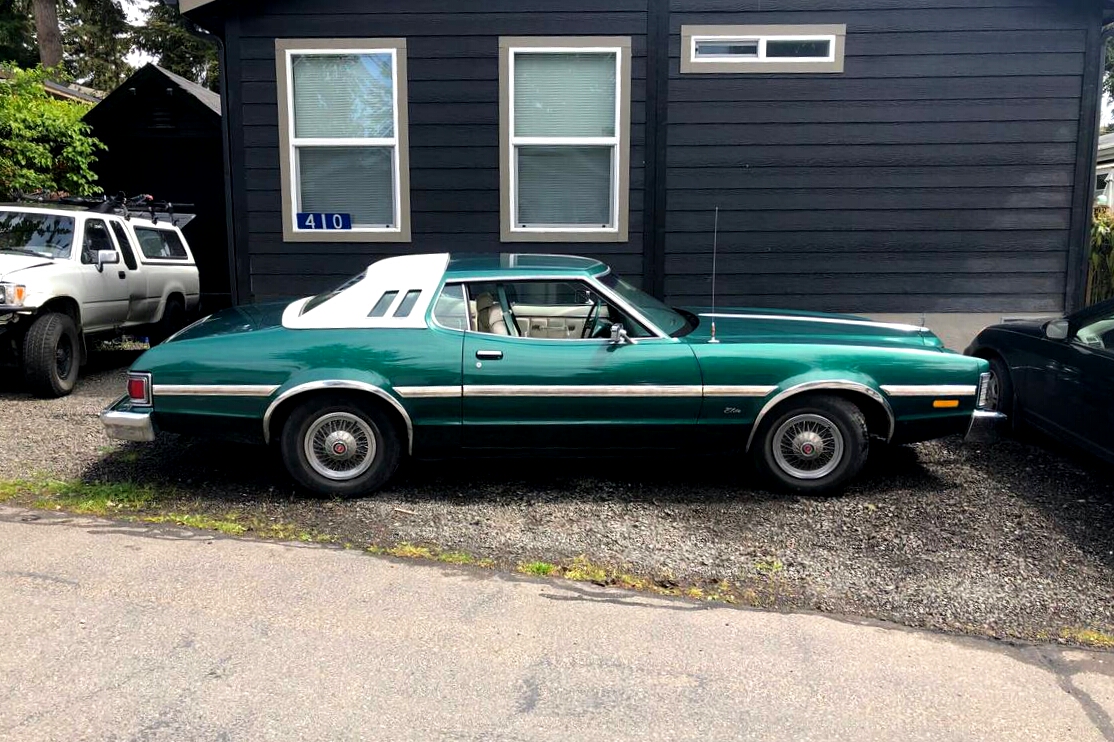
Every decade seemingly has its own personal fad. Most recently (and seemingly entering its second decade in the ’20s) it was the combover. Oops, I mean crossover, heh. Before that it was the SUV and before that it was the minivan. But the gotta have it vehicle type in the 1970s was most definitely the personal luxury car.
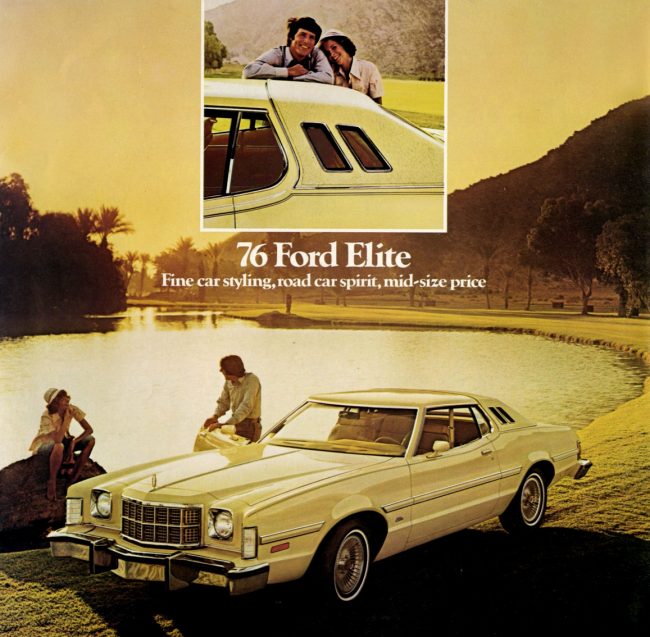
To wit: A two door coupe or two door hardtop with a long hood, short deck, gigantic doors, and likely sporting a stand-up hood ornament, opera windows, opera lamps, a landau top and wire wheel covers.

This type of very American Motor Vehicle got started in the late 50s with the four-seat 1958 to 1960 Ford Thunderbird. It was followed in roughly chronological order by the 1961 Oldsmobile Starfire, 1962 Pontiac Grand Prix, pricier and more exclusive 1963 Buick Riviera, 1966 Oldsmobile Toronado (with front-wheel drive, wowie zowie!), the 1967 Cadillac Eldorado and the 1969 Lincoln Continental Mark III.
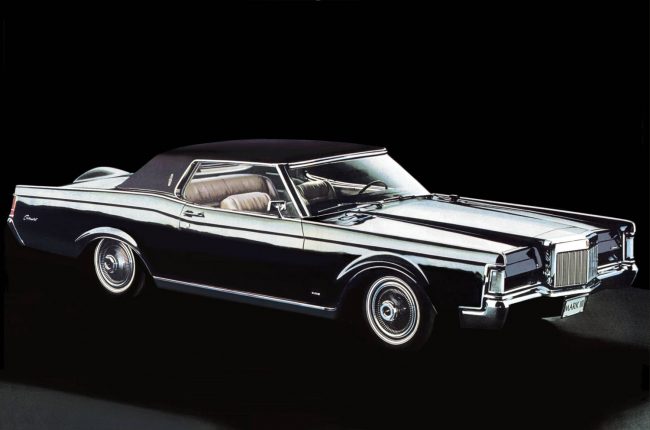
But these were primarily very expensive top-of-the-line cars and the rapidly emerging middle class wanted one of their own versions-albeit in a slightly smaller, more price-friendly fashion.
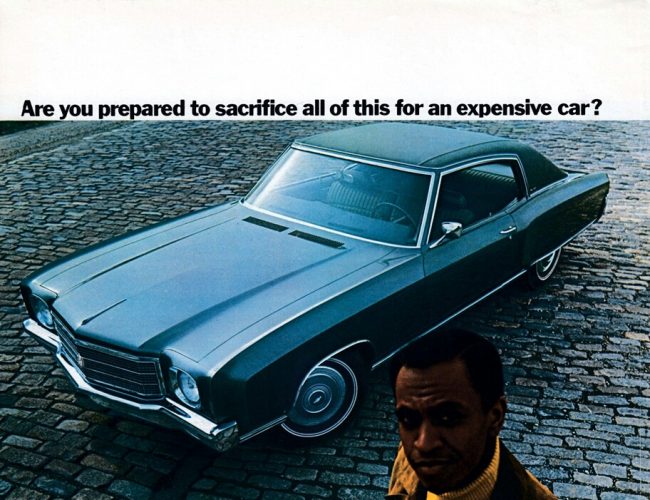
This new type of more affordable midsize middle class personal luxury car got started with the 1969 Pontiac Grand Prix and 1970 Chevrolet Monte Carlo.
The Monte Carlo was a success from day one and people rapidly stormed Chevrolet dealerships in ’70 to buy their copy.
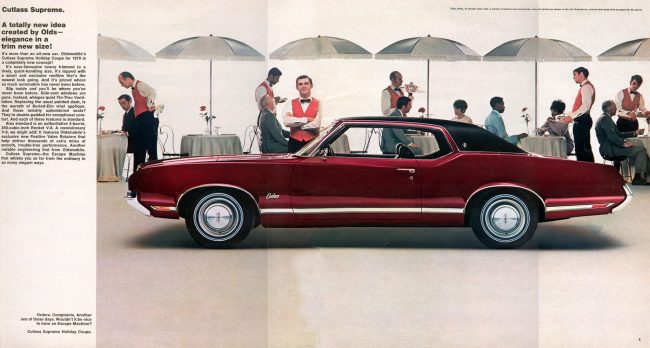
Clearly Detroit had struck gold. Starting in 1970 Oldsmobile got a Cutlass Supreme coupe with its own unique formal roof to set it apart.
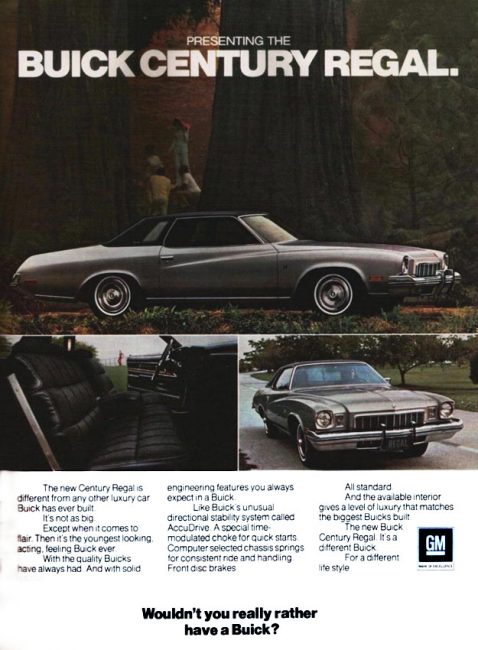
Then in 1973 Buick got its own version in the Regal, though it shared its formal roof with the second banana Century Luxus coupe.
Meanwhile FoMoCo was looking on at GM with envy. Sure, they had the Mark and T-Bird, but nothing in that fat midsize personal-lux segment. So they got rolling…
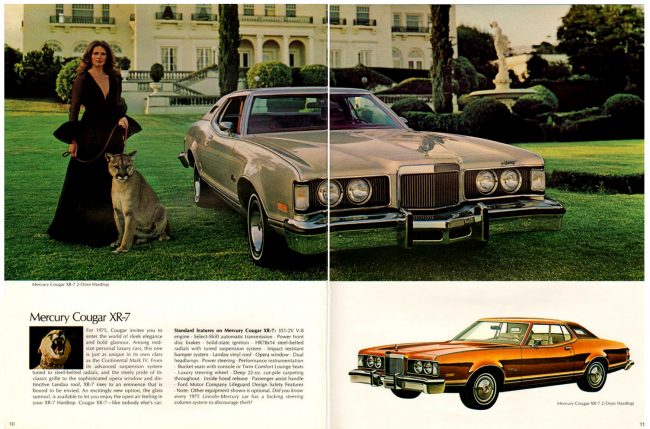
Starting in 1974 the Mercury Cougar stopped being a companion to the Ford Mustang and moved Uptown to the mid-size Montego’s chassis. It was fatter, plusher, and had those ever more important opera windows, hood ornament and extra chrome. And Ford got a version.
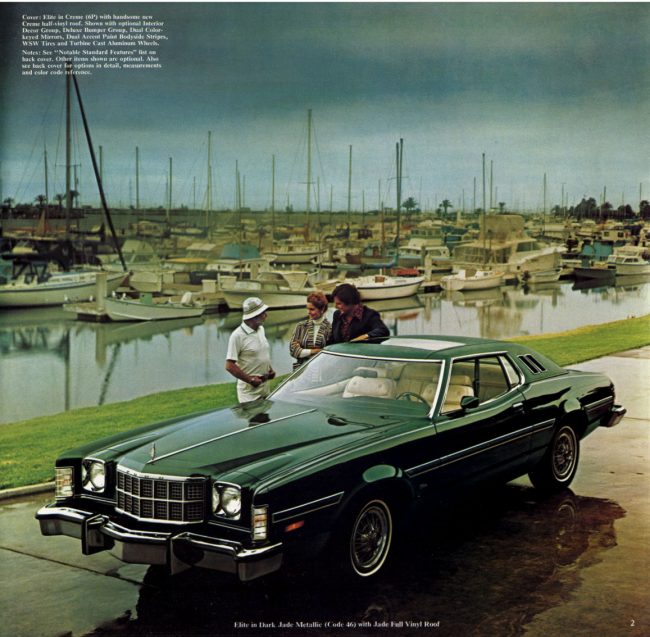
It debuted as a top-of-the-line Gran Torino listed in the dealer brochures as the Gran Torino Elite.
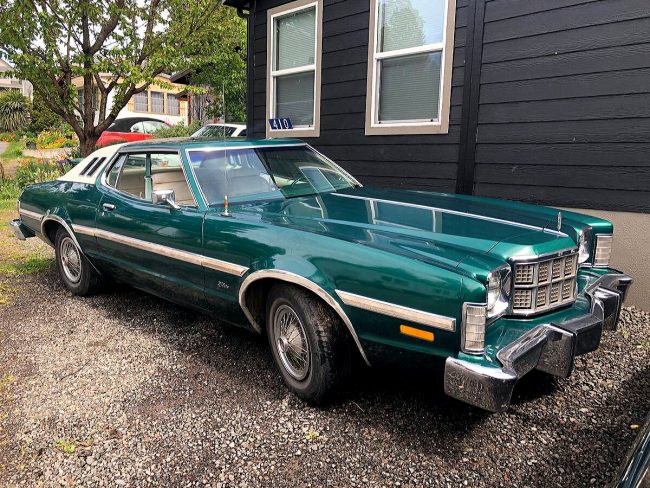
Naturally, it was very similar to The Gran Torino 2 door hardtop and the Mercury Montego 2 door hardtop and the Mercury Cougar XR-7, but with a different nose with single headlights in a massive chrome bezel, unique, glitzy grille and different taillights.
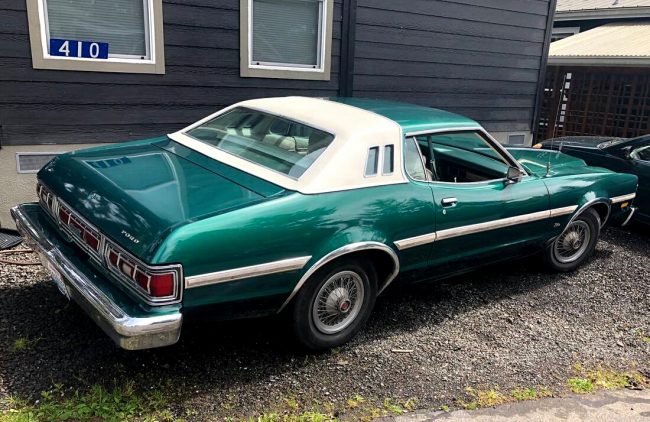
It also sported unique dual opera windows. Hey, it was the style during those turbulent, bell-bottomed, leisure-suited times. And it sold like dime beer at a baseball game.
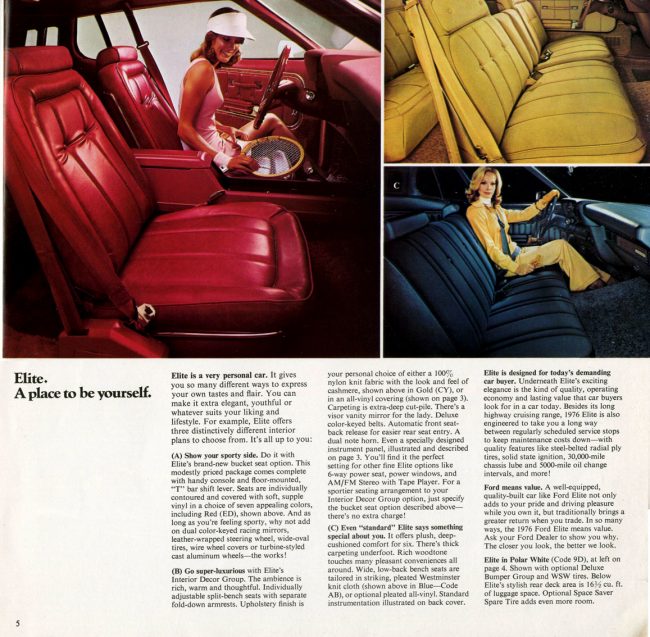
In 1975, the Elite lost the Gran Torino badging and became simply the Elite, with a new fender emblem in appropriately fancy script.
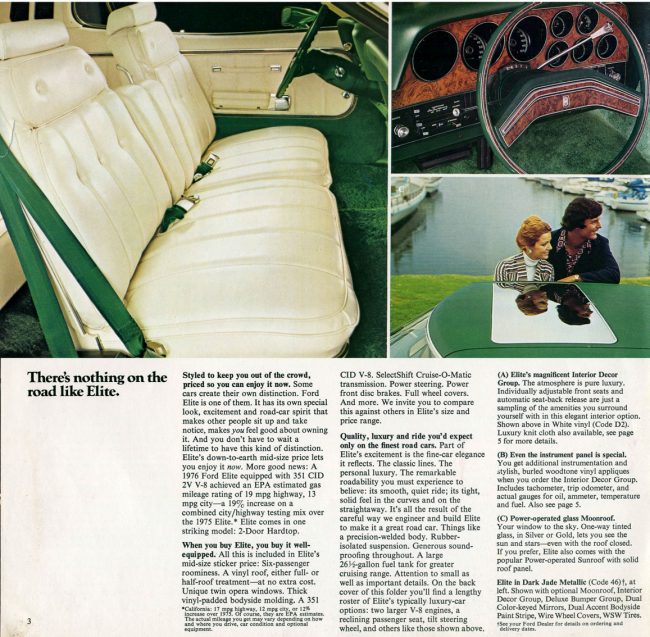
For 1976 the Elite appeared for the last time, with only minor changes.
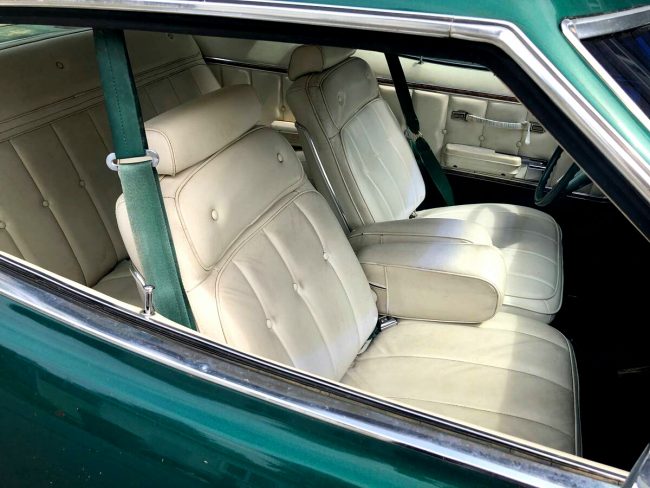
Yet it still managed to sell 146,475 copies, with a base price of $4,879. Standard equipment included a 351 CID V8, SelectShift automatic transmission and power front disc/rear drum brakes.
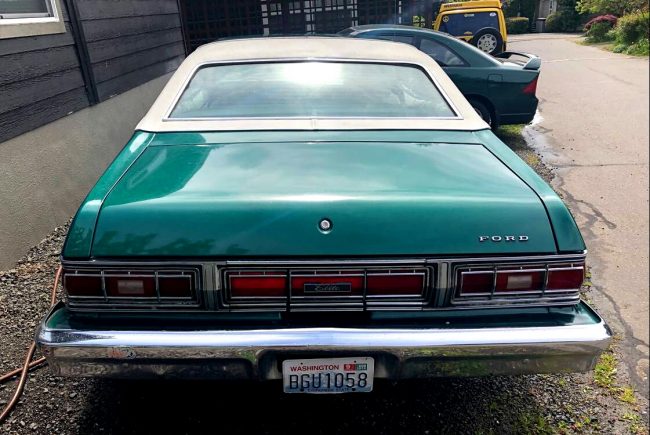
As you would expect for a personal luxury midsize coupe there were plenty of optional extras. Options included cruise control, power windows, a power trunk release, SelectAire A/C, a power sunroof, bucket seats and console and a 6-way power seat.
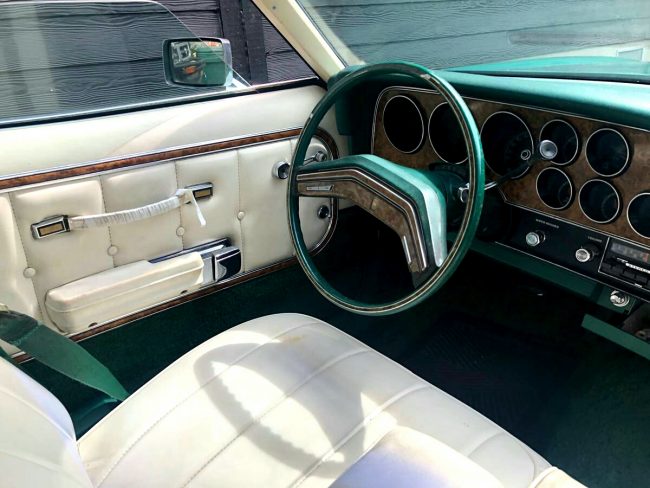
This fantastic green and white example was spotted recently by your author on Seattle Craigslist, where it was listed for a mere $2,500. The ad has since disappeared so I guess somebody got a deal. But I’ve always loved that ’70s Ford jade green, and I only worked this morning, so it was a good way to keep busy on this partly cloudy Thursday!
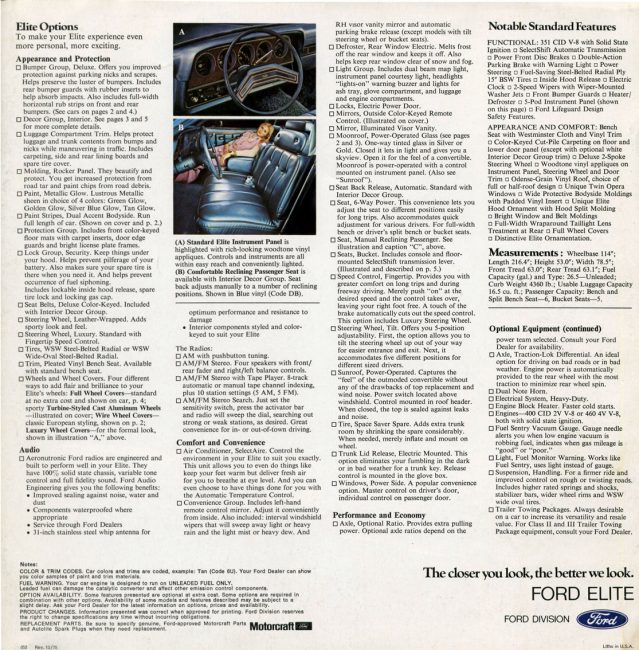







22 Comments
Not quite the same but I once had a 1973 Gran Torino Sport fastback in Dark Green Metallic. More of the tail end of the muscle car era with the 351 Cleveland four-barrel but still – I have a very soft spot for these platforms
Interesting in that it indicated the hole in the line below the expensive Thunderbird. I wonder how the profits worked out 76 versus 77 with some Elites and a few high margin Tbirds versus the better styled 77much more numerous Tbirds with Elite like profit margins?
As an aside, I had forgotten how much I liked the 74 Cougar. The legacy of being a high end Mustang had endowed the 74 with more performance grand touring options that seemed aimed at the Grand Prix of the time. Too bad Dodge wasn’t ready with the Magnum XE. A streetfight between the big three actually between cars they thrive on building.
What’s the difference between a Charger and a Magnum? In 1974 you could still get a Charger with the 440, or with a 400 and a 4-speed. From 1975, the Charger was the same Dodge Cordoba that the Magnum would be. I don’t think the lack of covered headlights would have mattered at any speed the street cars could reach.
You are engaging in the modern absurdum that speed is the only arbiter of what is cool. Imagine our young hero of the time, who having done the work of university and actually finds a plethora of opportunity upon graduation. I know this will sound otherworldly to our younger readers. After becoming entrenched in his well paying job, he is ready to trade his slant six hand me down Belvidere for a new upscale offering. Given who he is and where he is going, he has got several goals. The bachelor pad to fully enjoy his search, and the upscale plc that will communicate to the daughters of the prominent who he is and where he is going. Does he pick the maximum performance, or maybe just A/C, CC PW, nice wheels, base V8 more for sound than speed, and say T/tops to tell the ladies that time with me is fun. A car that was designed for who could buy it; a Magnum, a Cougar, or a Grand Prix.
I thought those guys had their Mickey Maoist club cards and bought new cars from Sweden or Japan?
I love this comment.
What a great description of the auto-buying public of the 1970’s. Did people really not care about speed? Or was it more a function of fuel scarcity – so the car makers focused on other things to make their car desirable?
Your reply to CJinSD also got me thinking. We now focus on the late 60’s / very early 70’s as the “muscle car era” but I am assuming that it was a very small subset of new car buyers at the time. Has our infatuation with speed given us the wrong view of the car buying public? Did Ford sell more “Secretary’s Mustangs” than V-8 fire breathers?
Remember also it was very hard to talk about speed in the 1970s. Somewhat due to emissions but also the switch from gross to net horsepower. You were doing pretty well to have 200 net horsepower in your mid size. Compared to the imports that was pretty good with almost 2 times the horsepower with 50 percent more weight. Against a 60s car, 200 horsepower was the gross rating for the slow base V8. The prospective buyer is not going to understand that 200 now is a lot more than 200 then, just let him drive it and the still ample torque, better transmissions and sound, deadening will still seem like dream ride compared to the Belvidere So the talk had to be about style, which was always most of the talk before anyway. The speed in a straight line folks were better off sporting last decades style, and well they should because quality improved all the time and you saw ever more old cars still serving..
The reason that Hemi Cuda’s and Cobra Jet 428 Mustangs, etc. bring big money today is that very few were sold when new, and half of those got rodded, blown up, or junked during the 1970s fuel crises. Most Mustangs had the base V-8 (289/302 two barrel), most Cuda’s had a 318 or station wagon 383, because the real hot ones were expensive to buy (relative to incomes of the time), expensive to insure, expensive to drive (6-10 mpg on premium fuel), and painful to own (required constant tuning, heavy clutches and steering, noisy on the highway with their drag racer rear end ratios, etc.). The big difference between the 1960s and 70s was the 1960s at least offered the opportunity to buy the hot version even if most bought the modest version, but the 1970s took the hot options away. Throw in primitive smog controls, unleaded low compression ratios, a few hundred pounds of impact bumpers, some sudden jumps in fuel prices, and 55 mph speed limits and the attraction and capabilities of big V-8 powered vehicles were greatly reduced.
There’s a real gap in the marketplace without this sort of car these days. I think the sort of buyer that had them in those days, is today buying a 4-Series BMW or an Audi A5, but of course with a significantly higher percentage of their household income than a Cougar or an LTD would have cost back in the ’70s.
I’d love to see a modern-day Thunderbird or Continental Mark X, built on the Mustang platform. The Mustang’s performance specs are formidable, but its size and weight always seems to me more suited to a GT car than a true canyon-carver. Give it the same quality interior that we’re seeing in Lincoln’s stunning SUV’s, price it in the mid-to-high 40k range to undercut the Germans, and I think they could steal some sales away from both German and Japanese brands.
> “There’s a real gap in the marketplace without this sort of car these days.”
The Challenger is still around, and selling better than ever.
> “Give it the same quality interior that we’re seeing in Lincoln’s stunning SUV’s, price it in the mid-to-high 40k range to undercut the Germans, and I think they could steal some sales”
Well sure, if they sell a car for less than it costs to make they’ll probably move a few. But I’m not sure that’s a very sustainable business model, particularly since every segment but crossovers and full-size pickups is on the decline.
Exactly. Detroit liked selling these cars because their bones were amortized by millions of workaday intermediates and everything you saw or touched was fake and as cheap as packing material. That left them with money to spend stumbling around trying to make a car pass emissions and hold an idle without biting the bullet and using electronic fuel injection.
There isn’t a market for two door SUVs or pickup trucks, but someone thinks there’s a market for two door faux pimpmobiles? If you added up the total annual production volume of all the Boomer coupes from Chevrolet, Dodge and Ford; you wouldn’t have as many 4,000 pound ‘pony’ cars as Ford sold Thunderbirds-in-name-only in 1978.
Well they had to cut corners in a few places in order to pay for those 10 foot long coolant hoses that connected the radiator and anemic motors under the 12 feet of hood.
Mine was a ’72 Eldorado. 42 feet long, 500 inch engine, 25 gallon fuel tank, opera windows, and black and chrome. Loved that car. Mileage, not so much.
I used to be intimately familiar with all of these mid sized Fords as our family was a Ford family growing up. We had a string of Montegos, Torinos, etc., etc. One of my buddies in the neighborhood got a 1976 Elite with the 351. We were 17 at the time, so that car was his “ride”, he was quite proud of it. He spent a lot of time stocking green beans in the local grocery store saving up for that car…
Another guy we knew got a 1975 or 76 Chrysler Cordoba (with the 400 IIRC) shortly after. Even though both of those cars were standard PLCs of the time, I liked the ‘Doba so much better. It seemed roomier inside and rode & handled better than the Elite. The Elite was pretty zippy in a straight line, but the handling and braking was just scary. That ‘Doba would smoke the Elite every stinking time. Honestly, my buddy needed to get a sports car with the way he drove that car, it really wasn’t any fault of the car. It was meant to be a cruiser, not a racer.
I also love that Jade Green that Ford used from time to time. My brother had a 2000-era Mercury Sable back in the day. It honestly looked a great big green insect, but I thought it was cool. There are few green paints that I like, but the Jade Green is a winner, in my book.
The problem for the Elite created expectations because it aped the styling of the Monte Carlo, which was actually a pretty good handling car for its era, but the Elite (and Torino it was based on) were among the worst. My sporty car favoring uncle bought a new Elite and had it for less time than any car he ever owned because he couldn’t stand the sloppy handling (and horrible fuel economy).
I’ve read that the first generation Monte Carlo mimicked Mercedes-Benz caster settings in order to give it excellent steering feel and high speed stability, but did handling survive as a priority into the second generation cars? I know Pat Bedard often described the second generation as the worst car in the world, which I can’t see him doing if it was still the best-driving GM car.
Actually it was the 2nd generation that John DeLorean ordered to get the MB copy caster settings and I believe a bit stiffer suspension bushings and quicker steering ratio versus the rather mushmobile 1st generation. Critics of the 2nd generation were more about the over-the-top styling flourishes that the public loved.
you are correct – the second gen handled exceptionally well, better than any other GM save the Corvette
Neighbor had one for less than a week. His wife hated the thing so bad he had to get rid of it. Gold with a vinyl roof. Racking my brain to remember what he replaced it with. Pretty sure it was a 4 door and dark. Also pretty sure he took a shellacking doing that.
Maybe he should have traded the wife!
Ok – we need a “like” function for the comments here.
I was just a kid and thought that at the time.